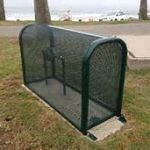- Written by water

What is a backflow cage?
Backflow preventer enclosures (backflow cages) come in a variety of materials all with various levels of protection. For backflow prevention devices 3″ and smaller, it’s very common to see backflow cages. These cages are typically made of expanded metal and are relatively inexpensive to produce in small sizes. This is what has led to their popularity for irrigation/sprinkler backflow preventer protection. Backflow cages are also popular in warm environments like Arizona, Texas, and California where there is little to no danger from freezing. This is the best use of these types of enclosures, because they offer no freeze protection and are not as reliable upon during the winter in most areas. Whatever climate you’re in, here’s what you need to know about backflow cages, and if you need more information call us at (817) 996-2000. We are City Backflow Testing and we know all things related to backflow.
Specifics about backflow cages . . .
Protection: These have no insulation at all to provide frost or freeze protection, but do provide some protection against vandals and accidents as they are typically powder coated steel and do include a locking mechanism.
Sizes: from about 24″ x 24″ up to around 60″ x 60″
Prices: $300 to $3,500 depending on both size and style
The pros of a backflow cage
Cages are designed to protect devices from theft and vandalism. Backflow valves are made of copper, brass, or galvanized steel pipe. These are valuable metals and when the recession of 2008 began, backflow preventer theft increased dramatically. Areas that previously didn’t need an enclosure now did to prevent this theft. They had a few different options, and cages became the go to solution for these areas. Since they didn’t require freeze protection, cages would work well for them. Backflow cages were perceived as more cost effective than aluminum or enclosures made from fiberglass, and this was certainly the case at the time, and the pop up of many backflow cage manufacturers established the habit of using cages. The cages were relatively inexpensive, they were easy to get, and they acted as a sufficient deterrent to theft.
The cons of a backflow cage
Cages offer no protection from the elements and are really only useful in climates that rarely, if ever, reach temperatures below freezing. In order to provide any insulation to the pipes, the user must either purchase an insulating bag, or take matters into their own hands if the weather turns. Surprisingly, cages are sometimes prevalent in areas that do freeze regularly, such as Denver, Colorado. It’s common to see irrigation back flow preventers from .75″ to 4″ in cages year round. During the colder months, they are often wrapped in garbage bags. The reason for this popularity, is because cages were the most cost effective option when they first came on the market. However, the cost of manufacturing other solutions, such as fiberglass enclosures and aluminum enclosures, has become more comparable to the cost of manufacturing cages. Now, these options cost about the same. Insulated enclosures provide extra protection – not only from the climate, but also further protection from thieves. A simple, boring box is much less likely to be tampered with than a see through cage. This is because a would be thief already knows there is valuable metal inside a cage because they can see it. That’s not the case with an aluminum enclosure.
About City Backflow Testing
We are City Backflow Testing and we know all about backflow, backflow inspection, and backflow cages. Give us a call for more information and for installation, repair, and inspection of your backflow devices in the Fort Worth area.
Posted in Backflow Prevention

